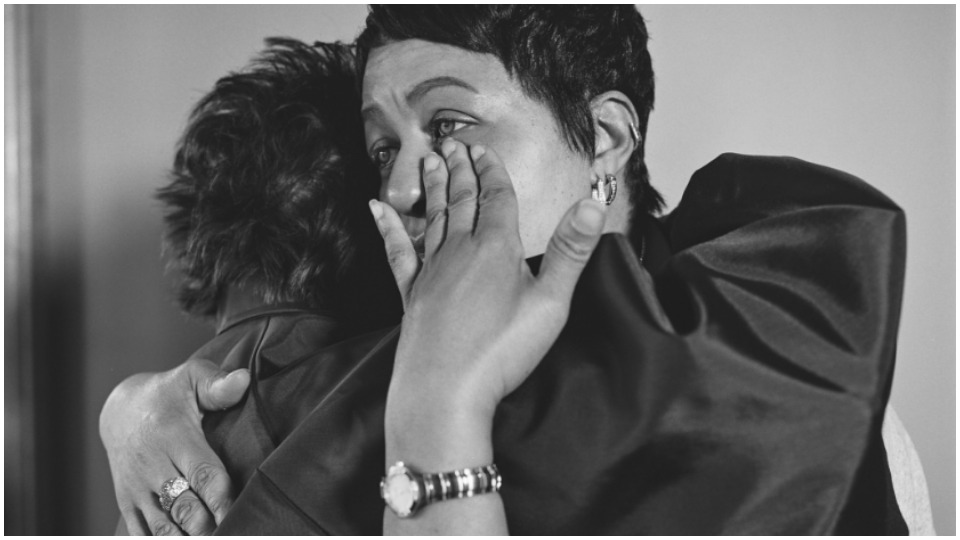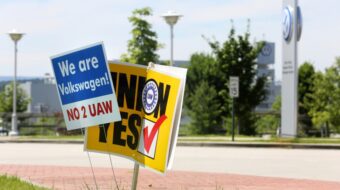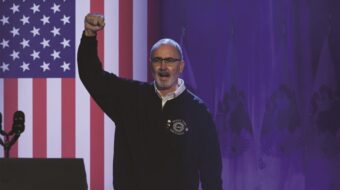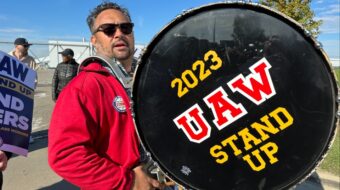
CHICAGO—Painful. Haunting. Partisan. Resilient. Solidarity. These words come to mind when describing LaToya Ruby Frazier’s powerful photographic exhibition of Lordstown, Ohio, autoworkers, documenting the shutdown of the General Motors (GM) plant there earlier this year.
The exhibition, entitled The Last Cruze (on now at the Renaissance Society in Chicago), is an ode to the workers who built the Chevy Cruze at Lordstown while shedding “visibility on people that were being crushed and erased and ignored.” The exhibition opened the same day the contract between the United Auto Workers union (UAW) and GM expired, precipitating the nationwide strike of nearly 50,000 autoworkers.
GM Lordstown had been an integral part of the Mahoning Valley for 52 years, employing generations of autoworkers. The plant employed 1,400 workers when it was shut down on March 5. A study by Hedge Clippers revealed Wall Street hedge fund managers pressured GM for four years to shut down the plant and four others to bolster shareholder profits. GM stock rose the day the shutdowns were announced.
GM announced the Lordstown plant had been “unallocated,” a sleight of hand to cover the betrayal of contract language keeping production going until at least 2021.

The exhibition is a complete version of the acclaimed photo essay that appeared in the New York Times entitled, “The End of the Line.” The photos and accompanying texts are stunning portraits of the lives of the workers captured in the social fabric of their jobs, families, union, and community. “These are very personal, painful intimate details and stories of everything they are still going through,” explained Frazier in a talk at the exhibition opening, Sept. 14.
“It’s really an honor to be able to share my work to serve the UAW in this country and to advocate why we need unions,” said Frazier. She asked the many union members present to stand, including UAW Local 1112 President David Green and Financial Secretary Rick Smith. It was the first time many of the workers had seen each other since the shutdown. The workers have been forced to accept transfers to other GM plants, leaving behind families and friends, or lose their accumulated benefits.
For Frazier, what happened in Lordstown hits home. The young African-American artist grew up in a working-class family in Braddock, Penn. Her step-grandfather worked at Edgar Thomson Steel Works. She witnessed the shutdown of the Pittsburgh area steel industry in the 1980s. This experience, which she documented in “The Notion of Family,” shaped her working-class partisanship and made her deeply attuned to the resulting social crisis and upheaval.
Frazier is currently an associate professor of photography at the School of the Art Institute of Chicago and recipient of numerous awards. She has dedicated her artistic life to giving voice to workers through pictures, video, and words. Her works are unparalleled in their empathy, sympathy, solidarity, anger, and warmth.

Last Cruze, 2019. | LaToya Ruby Frazier
In 2015, Frazier received a proclamation from the Allegany County Council thanking her for “examining race, class, gender, and citizenship in our society and inspiring a vision for the future that inspires equality, inclusion, and justice for all.”
Moreover, her work is a call to action.
“I just allowed my creative gifts and talents to be there for how they wanted to shape and visually represent the story,” said Frazier. “Just like how an attorney represents a client, I visually represent everyday working-class people. And I’m representing your side.”
Frazier’s documentation of working-class life puts her in company with other great social artist photographers like Dorothea Lange, Gordon Parks, Lewis Hine, Jacob Riis, and Milton Rogovin.
“All of my work is about family and community. It’s about how corporations and government kind of dismantle and reconfigure our families. None of us is untouched. So, it’s about family, in the plant, on the line, in the union hall, and family with their actual blood relatives.”
Frazier thanked her UAW “family” for making the entire project possible. To gain access to the workers’ lives, Frazier presented samples of her previous work to the union, including “Flint is Family,” on the Flint water crisis. The local actually took a vote to collaborate with her, which Frazier proudly noted was “unanimous.”
Lordstown workers were also represented by UAW Local 1714. Workers who drove the Cruzes onto the lot were represented by the Ironworkers.
“The entire exhibition is collaboration. It’s like social democracy at its best in action,” Frazier noted. The collaboration resulted in the layout of the exhibition, which is set up like an assembly line. The photos are mounted on bright orange wooden panels replicating the carriers that held the Cruzes. GM refused to allow Frazier into the plant, once even threatening to shoot her. So, Frazier collaborated with fellow photographer Kasey King, a Lordstown autoworker and Local 1112 documentarian, and drew from her photos of the production line. A video by King documenting the production of the Cruze accompanies the exhibition.

“Now, instead of holding the (last) Cruze, the carriers hold the portraits of the UAW, the friends, family, and loved ones. This is a collaboration with you (the audience) whether you realize it or not,” said Frazier. “By you walking up to the line, you’re on the line. If you engage and try to read the texts and look at the portraits, you’re on the line. And you’re switching roles between being the autoworker and the Cruze itself. You’re activating the space. Collaboration after collaboration.”
When Frazier first heard about the GM closings, she knew she needed to be in Lordstown giving voice through visuals documenting what the workers were going through. She literally became part of their lives and that of the union and the community, spending four days a week there for months.
The affection and appreciation toward Frazier by the workers were evident by their presence and gracious words. She became their sister. Frazier’s interviews became gatherings for groups of workers, some lasting well into the night. She heard stories of their lives and the history of the Mahoning Valley.
Frazier built special bonds with women workers, including some who had been through previous plant closings. “You worked at Youngstown Sheet and Tube? You survived Black Monday? To stand before someone who went through that history!”

Frazier was particularly incensed with the false narrative of the corporate mass media that the auto workers had nobody to blame but themselves for the shutdown. After all, hadn’t they supported Trump in 2016?
“The whole generalization to blame working people for our present political situation is actually inaccurate, prejudiced, biased—and I know it for a fact. And I’m showing it in the exhibition. To simply blame Ohio, Michigan, or Pennsylvania or the rustbelt is just a profound amount of ignorance,” said Frazier.
Frazier had no qualms about using the platform of the New York Times with the “End of the Line” photo essay to reach millions about the plight of the workers. But she never had any illusions about its limitations.
“The New York Times was never going to cover what happened in Lordstown, not in the magazine in the way that my images appeared,” explained Frazier. “They definitely never, never intended for the worker’s voices to be printed. Never. I fought for their voices to be in there.”
Frazier hired a helicopter to fly over the plant so she could get a photo of workers surrounding the last Cruze to come off the assembly line. Afterward, she flew over the union hall to photograph over 200 union members and their families and dogs.

“They stood in a circle like the UAW emblem. That’s the power right there. I knew I was in a position to create a visual representation of coming together in solidarity with all this unity trying to save their livelihood, the union, and workforce,” said Frazier. “The fact the New York Times suppressed the image, even though I repeatedly asked them to print it speaks even more volumes to me.”
“This is about education to reach out for support. Knowledge is power. This is about coalition building and helping people understand the real value of people’s lives.”
The Last Cruze runs through Dec. 1 at the Renaissance Society before moving to the Wexner Center for the Arts in Columbus, Ohio.












Comments